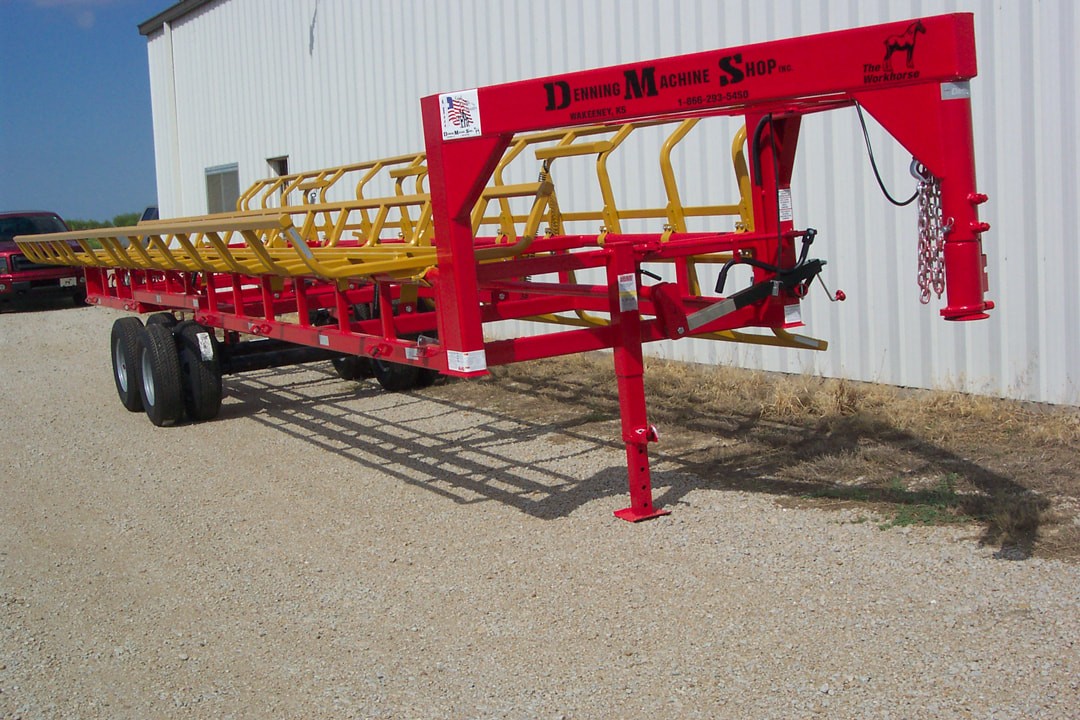
When you’re in the thick of high-frequency feeding operations, you don’t need a guess—you need gear that works every single time. If you’re moving forage for Total Mixed Ration (TMR) systems two to four times a day, a 14 bale hay trailer isn’t just helpful—it’s essential! It’s designed for high-use, high-efficiency, and hard-wearing ag conditions where downtime isn’t an option.
Let’s walk you through how this trailer size fits into your dairy feed system—and what to watch out for.
Dairies running TMR programs understand the pressure—precision-timed feeding, multiple daily rounds, and minimal room for delay. A 14 bale hay trailer offers a sweet spot between load capacity and maneuverability. Here’s why it works:
• Bed Length: Typically 36–40 ft—ideal for stacked 3×4 or 4×4 large square or round bales.
• Weight Rating: Up to 14,000–18,000 lbs, ensuring your hay or silage haul doesn’t overload axles.
• Axle Setup: Tandem dual 7K or 8K torsion axles with electric brakes, keeping transport smooth and safe—especially on uneven terrain.
These specs directly reduce the turnaround time between loading and feedout, and that’s critical when your herd depends on consistent nutrition.
Let’s be clear—you’re not hauling for fun. Every trip on a dairy is calculated. A forage trailer for TMR must do three things: handle load, move fast, and not break down. The 14-bale format supports high-frequency, low-downtime schedules typical of mid-to-large scale dairies.
Did You Know?
According to USDA 2024 reports, over 62% of U.S. dairies using TMR systems reported significant efficiency gains when upgrading to high-capacity trailers in the 12–14 bale range.
1. You’re Running Double Loads: If you’re hauling 7 bales twice when you could haul 14 once—you’re wasting fuel, labor, and time.
2. You See Uneven Bale Wear: Poor suspension or improper axle alignment can cause stress on bales during transport—damaging silage quality.
3. Your Trailer’s Frame is Warping: That’s a red flag. You may be pushing a low-duty trailer beyond its manufacturing intent.
These are common triggers for increased maintenance costs—and avoidable with proper equipment.
Off-the-shelf trailers work for some, but high-throughput dairy setups need reliability built from the ground up. That’s where customised hay trailer manufacturing parts come in. Whether you need reinforced loading rails, modified shearing angles, or tailored axle upgrades—custom machine work ensures your trailer is built for your terrain, your load pattern, and your daily feeding schedule.
Our team handles:
• Heavy-duty shear & brake operations
• Axle upgrades and drive line components
• Trailer frame reinforcements
• Custom welding and machining tailored to bale types
Ask yourself:
• Are your trailers keeping up with your TMR schedule?
• Do your trailer components match your feeding volume?
• Can your trailer handle both wet silage bales and dry hay without sagging or failure?
If the answer is “maybe,” it’s time to take a closer look.
That’s where our experts at Denning Machine Shop Inc come in. From hay trailer machine work to full custom builds and hay trailers for sale, our shop delivers precision manufacturing for agriculture. Whether you’re looking for reinforced tongue welds, custom-length beds, or upgraded hydraulic dump systems—we’ve got the in-shop tools and field-tested know-how.
With a focus on serving agricultural and industrial equipment clients, we understand what breaks—and more importantly, how to prevent it.
1. What is the ideal trailer length for a 14 bale hauling trailer?
Most 14-bale setups require a 36–40 ft deck, depending on bale size and stacking method.
2. Can a 14 bale hay trailer handle wet silage bales?
Yes—when built with high-tensile steel frames and torsion axles rated 14K–16K lbs, it handles silage with ease.
3. What upgrades improve trailer performance in high-use ag operations?
Custom shear & brake frame work, reinforced spindles, and upgraded braking systems are key for durability.
4. Are these trailers compatible with front-loaders or skid steers?
Yes—trailers can be fabricated with low-profile decks and loader-friendly tie-downs.
5. Where can I find custom hay trailers for sale near me?
Contact Denning Machine Shop Inc—we build, upgrade, and service trailers to match your dairy’s exact requirements.
When it comes to daily feeding efficiency, your trailer either saves time—or costs it. A 14 bale hay trailer delivers that critical balance of capacity, durability, and speed. And with the right fabrication partner, you’ll get equipment that fits your feeding rhythm—not the other way around.
Looking to upgrade your forage movement game?
Reach out to Denning Machine Shop Inc today—we’re here to weld, cut, bend, and machine your next move in efficient dairy feeding.
Let’s build it right. Let’s make it last.